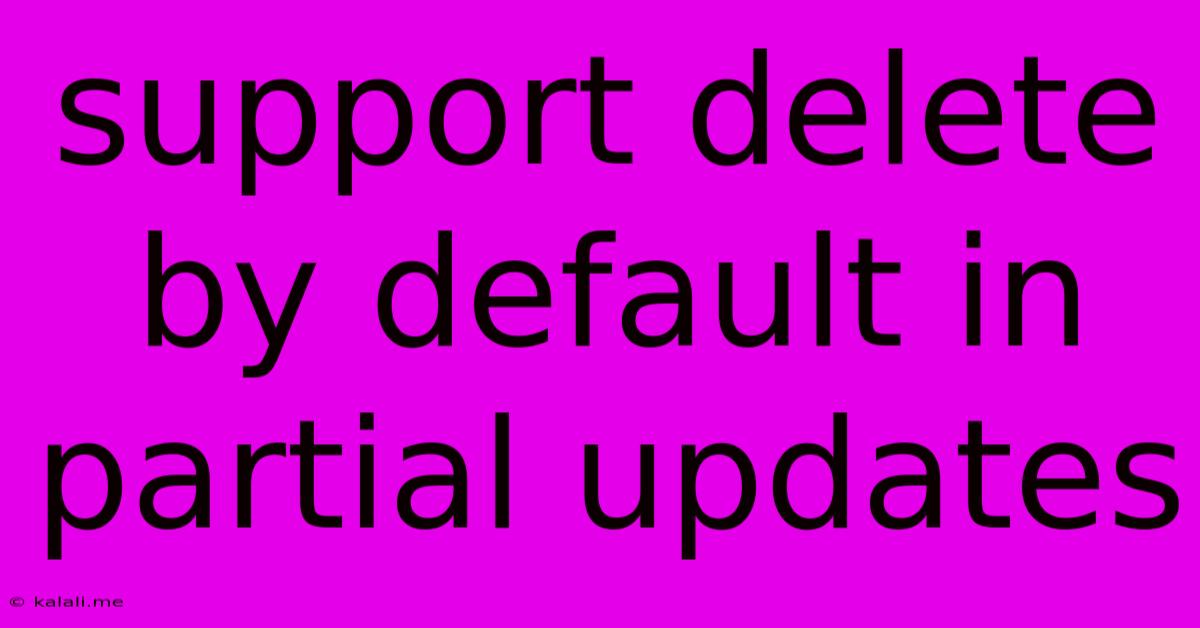Support Delete By Default In Partial Updates
Kalali
Jun 05, 2025 · 3 min read

Table of Contents
Support Delete by Default in Partial Updates: Streamlining Data Management
This article explores the benefits and implementation of supporting delete-by-default behavior in partial updates, a crucial aspect of efficient data management in various applications. We'll delve into the scenarios where this feature is particularly advantageous and discuss potential challenges. Understanding this concept can significantly improve the performance and scalability of your systems.
What are Partial Updates?
Partial updates are a mechanism for modifying only specific parts of a larger dataset, instead of replacing the entire dataset. This approach is far more efficient, especially when dealing with large datasets or frequent updates. Imagine updating a user profile: instead of re-sending the entire profile each time, you only send the updated fields (e.g., new email address). This reduces bandwidth consumption and processing time.
The Case for Delete-by-Default
Traditionally, partial updates often required explicit instructions to handle deletions. If a field was omitted from the update, it remained unchanged. However, a delete-by-default approach flips this paradigm. Omitting a field from a partial update signifies a request to delete that field from the dataset. This simplifies the process and reduces the need for complex conditional logic.
Benefits of Delete-by-Default in Partial Updates:
- Simplified Update Logic: Developers no longer need to explicitly specify which fields should be deleted. This significantly simplifies the codebase and reduces the potential for errors.
- Improved Efficiency: Reduced data transfer and processing, leading to better performance, especially crucial in high-volume scenarios.
- Enhanced Data Consistency: By clearly defining the deletion mechanism, the system ensures data consistency and reduces the likelihood of data inconsistencies arising from omitted fields.
- Easier Implementation of Data Versioning: Tracking changes becomes simpler with a clear indication of deleted fields, which aids in maintaining data integrity and supporting rollback functionalities.
- Better Scalability: Optimized data handling contributes to better scalability, especially in distributed systems.
Implementation Considerations:
While delete-by-default offers numerous advantages, its implementation requires careful consideration:
- Data Validation: Robust validation mechanisms are crucial to ensure unintended deletions don't occur. This might involve strict data schemas or user confirmations.
- Data Integrity: Implementing appropriate safeguards to prevent accidental data loss is paramount. This could involve audit trails or backup mechanisms.
- Backward Compatibility: If integrating this feature into an existing system, careful planning is necessary to ensure backward compatibility with older clients or systems that don't support this approach.
- API Design: Clear documentation of the delete-by-default behavior is essential for developers using the API.
Example Scenarios:
- E-commerce Catalog Updates: Updating product information, where omitting a field (e.g., price) might signify a removal of the product from the catalog.
- User Profile Management: Updating user profiles, allowing the removal of data like a phone number or address.
- Document Management Systems: Modifying documents, where removing a section can be signaled by simply omitting the data from the update request.
Conclusion:
Implementing delete-by-default behavior in partial updates offers significant advantages in data management, improving efficiency, simplifying development, and enhancing overall system performance. While implementation requires careful consideration of data integrity and validation, the benefits generally outweigh the challenges, making it a valuable strategy for developers working with large and frequently updated datasets. By adopting this approach, developers can streamline their data management processes and create more robust and scalable applications.
Latest Posts
Latest Posts
-
Wire Size For A 60 Amp Breaker
Jun 07, 2025
-
Fridge Is Working But Freezer Is Not
Jun 07, 2025
-
Why Does The Bird Die In The Vanishing Cabinet
Jun 07, 2025
-
Can I Delete Alias On Mac
Jun 07, 2025
-
How To Remove A Bolt With A Stripped Head
Jun 07, 2025
Related Post
Thank you for visiting our website which covers about Support Delete By Default In Partial Updates . We hope the information provided has been useful to you. Feel free to contact us if you have any questions or need further assistance. See you next time and don't miss to bookmark.